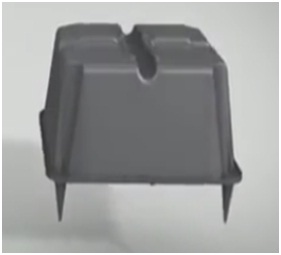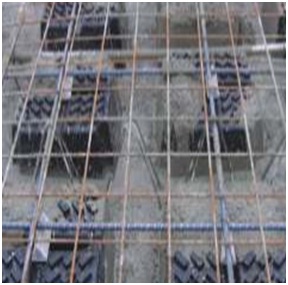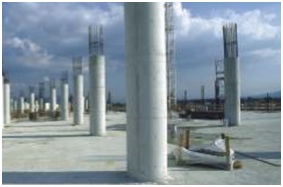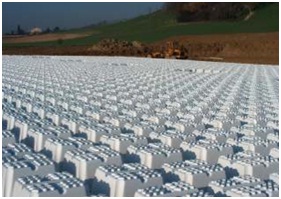





Published on Nov 30, 2023
U-boot beton is a formwork made of recycled polypropylene, designed to create lightened intermediate slabs and raft foundations in reinforced concrete. The use of U-boot formworks permits to build specific mushroom slabs: the mushroom is part of the slab thickness. U-boot remains dip into the concrete casting. Thus, a grid of orthogonal beams, superiorly and inferiorly closed by plane slabs of different heights, is obtained without executing two distinct concrete castings, all that implies a remarkable saving of concrete and reinforcement.
U-boot is used for structural elements of different types such as slabs or foundation grants solution preformation considerable designing technical and economic. Disposable formwork for two-way voided slabs in reinforced concrete cast on site. U-Boot Beton is a recycled polypropylene formwork that was designed to create two-way voided slabs and rafts. U-Boot Beton is used to create slabs with large span or that are able to support large loads without beams A lightweight, cellular concrete made by infusing an unhardened concrete mixture with prepared foam or by generating gases within the mixture.
Advantages compared with tradition play on cement systems those and light weight training or fully faceted to win slabs the traditional clay cement or polystyrene floor slabs. The traditional clay cement or polystyrene floor slabs normally consists of mono directional beings that discharge stresses on to the main beings from these two pillars and finally the foundations the full plate floor slabs instead are made from monolithic reinforced concrete casts in which the structure is able to bi directionally transmit loads directly to the by using U-boot and lighter slab structure is obtained capable of splitting the stresses in any direction transferring them directly to the penance to simplify the concept we could imagine a series of double teams of alongside the other and arranged as a premise all stresses will be concentrated close to pillars where the suitable full section gets left in this way floor slabs with mushroom like files for the repose in modern people specificity being that the mushroom is embedded in the floor.
So ,cutting or encumbering capitals and economic boxster’s and avoided thanks to the lightness of the structure doing away lightness of the work the passage of utilities and the layout of internal wards U-boot will make it possible to optimise the plan layout of pillars without having to keep the specific distributed limitations as well as reducing their number benefiting for more extension spans and without encumbrances the overall thickness of the floor slabs will also be considerably reduced and as a result they use full saving in height will be obtained for each individual forum is the possibility for tower buildings of gaining an extra floor with the same that involved compared floor with a full slab the wind saving will favourably influence the dimensioning of pillars and foundations and the thickness to be reduced in vocations the foundations will be less important and less stressed also behaviour under in case of fire the building greater lightness high inertia and reduced surface area reduced surface area exposed to the effects of heat confer autumn resistances to find from acoustic specific tests guarantee that a floor slab use
U-boot technology provides insulation performances that are superior compared with traditional clay or cement systems lightweight polystyrene zing’s a benefit of no mass importance is the better quality of the concrete surface finish to be left visible or ready for the skimming without further processing to the numerous advantages link to the work itself economic logistic and building site advantages are added for construction firms is processing less consumption of concrete and steel less handling n ground and overground this encumbrance with in the parameters of the site there’s transport and storage changes all things to a material is stackable tough and able to withstand all weather conditions first an hour will be handling a product that is safe from the light nonssoiling and easy to use u-boot is the ideal solution for all buildings in which judging beams structures would need to be avoided typically slab solution is sort together with savings in those concrete and weak the U-boot beton building system is particularly suitable for the construction of high-rise village hospitals commercial centres school buildings parking management residential and industrial buildings.
In case of raft foundations having a greater inertia U-boot makes it possible to implement sweaters with a better performance given the same concrete used the grounds are found to have a low carrying capacity furthermore be possible to eliminate or reduce complex andcostly foundation pockets.

Laying of avoided two-way elements is swift and simple the reinforcement and U-boot elements are laid out on top of the decade according to design specifications ready to receive the concrete casting the layout does not require specialised personal the correct distance between the elements is assured by aspacer jumped equipped with a graduated scale by means of which the widths the o beams being formed with the casting can be rapidly determined at the top this joint gets inserted in specific looking for difference provided on the upper surface of the U-boot the entire operation is precise handy and rapid once the concrete is poured avoided structure is permanently embedded providing the structure with the desired shape on the technical timing for the setting having last the backing will be dismantled the intros service will prove to be completely smooth formwork can also be used in combination with predominate facing the voided load directly on te plains and completing the finishing casting.
U-boot is used in all applications that require a plate structural solution, along with concrete-savings and therefore weight-savings. In tower buildings, weight-saving at every floor reduces load on foundations. The fact of avoiding beams being out of the slab thickness, enables the reduction of height for each floor.
Therefore, a higher number of floors can be built. By using U-boot beton, it is possible to build thick raft foundations with a reduced quantity of concrete (and weight). U-boot is the ideal solution to create slabs of big spans and/or with a high bearing capacity. In case of difficult access to the building site or restructuring, U-boot beton permits to build up the horizontal structures without using lifting and movement devices, because of its stackability, modularity, lightness and manageability.

The study includes the results of an extensive experimental program conducted at the Polytechnic of Milan, which highlight the excellent bidirectional response of voided slabs and the efficient performance in the presence of seismic actions. The experimental results here presented are supported by advanced numerical models
The U-boot system particularly fits structures that need significant open spaces, like bureaus,industrial and commercial buildings, and civil constructions as well. The system also allows a more irregular distribution of pillars, since beams are not necessary
U-boot beton formwork is an easy to use product. First, a flat and complete surface has to be prepared with a wooden deck or any other similar system. Then, the inferior steel reinforcement hasto be posed in the two orthogonal directions, as designed in the executive project; the lattices are finally posed in order to space out upper reinforcements.

Afterwards, U-boots are laid down and connected by lateral flaps, respecting the required span between the lightening space. Thanks to the cone shaped feet, U-boots are raised above the slab intrados, and the concrete can thus be cast, filling the whole surface below the elements. If double elements are to be used (H32, H36, H40, H44, H48), it will be necessary to pre-emptively assemble the two parts, that will be delivered in different pallets at the building site.
The reinforcement pose is to be completed by disposing the upper bending steel bars in two directions, the shear and punching reinforcement, where necessary. Due to the floating pressure exerted on U-boots, the concrete should be cast in two different phases: the first casting has to fill a thickness equal to the feet height.
The final phase has to be done when the first concrete layer starts to set and becomes semi-solid. Casting proceeds each time from the previous starting point. While the casting proceeds, the concrete sets. Finally the casting has to be levelled up in a traditional way (picture 6). The U-boot system execution time will be accelerated by using new deck technologies which permit to disassemble within 2-4 days, or using the carpet reinforcement system, in order to reduce the steel bars posing time up to 4-6 times

U-boot slabs do not need beams between pillars, a perimeter edge beam is enough. The orthogonal grid of beams transfers all stresses directly on pillars; around which it is enough to leave a massive area, called mushroom pillar, which is thick as the slab and variable in function of shear stresses
Among foundation different typologies, raft foundation is surely one of the most known and used, considering its evident technical advantages: high stiffness due to its static bidirectional behaviour, and thus load partition capacity on the ground; it also permits to absorb stresses coming from the building, with differential subsidences close to zero; easy and quick to carry out. If stresses increase or the ground bearing capacity decreases, the structure may require a thick raft foundation.
This means having more concrete and more pressure on the ground; and therefore higher building costs. U-boot beton is a formwork made of recycled polypropylene, purposely designed to build lightened plate slabs and raft foundations. Once drowned into concrete, it creates an alveolar structure with two slabs of different thickness, joined by an orthogonal grid of beams of variable width, therefore building an ideal light structure for raft foundations.
Statically, it can be seen as a grid of I beams which means having a rationalized masses distribution for the purpose of inertia, in order to get high stiffness with a minimum quantity of concrete. This perfect combination of lightness and stiffness permits, in particular cases, to avoid using foundation piles.
Polystyrene is a widely used material in the world of building, especially if associated to prefabricated slabs, because it is cheap and malleable. However, in the last few years, the technicalscientific community has been focusing on its numerous disadvantages. First of all, the fact that polystyrene releases toxic styrene monomers, at room temperature.
Moreover, some studies carried out by the Polytechnic University of Milan highlight the fact that a slab lightened by means of polystyrene explodes after only 20 minutes, if exposed to fire load. This is partially due to the presence of warm air into the cavities which increases pressure, and partially due to styrene sublimation. That is the second problem. In order to avoid slabs explosions, prefabricated slabs producers recently planned some vents into the slab to maintain external pressure into cavities. But in this case, the styrene flows out from the cavity, and it is toxic. On the contrary, U-boot is made of polypropylene which is not toxic even if it burns. Moreover, the CSI laboratories carried out a fire test on a slab lightened by means of U-boot and with a 3 cm concrete cover, and the structure was certified REI 180 minutes. The certification is available on request. Finally, polystyrene is a material which needs huge volumes for transportation and stock on site; U-boot beton is designed to be stackable.
Correct positioning of the U-Boot Beton is guaranteed by an effective rigid spacer joint with graduated scale with which the desired width of the beams is quickly determined. The joint fits into the top of the formwork inside notches housing the fixing elements.
The rigid interconnection ensures perfect geometric compliance with the design as well as with the bearing capacity of the formworks when casting under the pressure of the concrete, the weight of the operators and equipment.
U-boot beton is a recycled polypropylene formwork that was designed to create two-way voided slabs and rafts. The use of U-boot beton formwork makes it possible to create mushroom pillars, with the possibility to have the mushroom in the thickness of the slab.
Thanks to the conic elevator foot, immerging the U-boot beton formworks in the concrete casting will create a grid work of mutually perpendicular beams closed from the bottom and the top by a flat plate that is created with a single casting; this results in considerable reduction in the use of concrete and steel.
U-Boot Betonis used to create slabs with large span or that are able to support large loads without beams. Light and quick and easy to position, thanks to their modularity the designer can vary the geometric parameters as needed to adapt to all situations with great architectural freedom.
Designedf or bidirectional slabs , Decrease of concrete and weight up to 40% ,Reduced deformation (maximum stiffness loss 15%) , Reduction of load on foundations , Reduction of pillar section
Spans up to 20 m, Absence of beams between pillars, Reduction of pillars number, Possible use with prefabricated slabs, No lifting and movement devices required, ideal for restructuring, Possible creation of monodirectional slabs thanks to the “bridge” accessory
Reduced seismic mass, Less dimensional limitations of elements , Double inferior and superior slab
More spacious rooms , Bigger architectural freedom , Easier change of use
Less concrete incidence, thickness being equal , Less steel incidence , Usable height saving on each floor, since avoiding beams being out of the slab thickness enables a higher number of floors, height being equal (tower buildings) , Rapidity and easiness of pose (unique twophased casting) , Possibility of big spans, load being equal , Possibility of high bearing capacity, spans being equal , Economical transport and easy stocking, since it is stackable, Ready to smooth once the deck is taken off, the intrados is a plane surface which do not require false ceilings at an aesthetical level , If a false ceiling is necessary, pose is made more rapidly
Significant fire resistance (certification REI 180; concrete cover 3cm)
This is most ecofriendly and advanced technology. U-boot remains dip into the concrete casting. Thus, a grid of orthogonal beams, superiorly and inferiorly closed by plane slabs of different heights, is obtained without executing two distinct concrete castings, all that implies a remarkable saving of concrete and reinforcement.
1. Foundation design by Nainan.P.Kurian.
2. IS 15284(part 1)-2003 design and construction for ground improvement- Guidelines (Part 1) - Stone columns.
3. IS 13094-1992 Ground improvement-techniques on weak soil.
| Are you interested in this topic.Then visit the below page to get the full report |